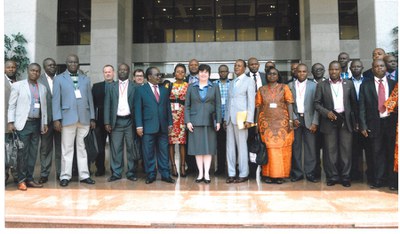FCMC-organized Congo Basin REDD+ Capacity Building Workshop

The workshop was opened by US Ambassador to the Congo, Stephanie Sullivan, the Honorable Raymond Mbitikon, Executive Secretary of the Central African Forest Commission (COMIFAC), and the Honorable Henri Djombo, Minister of Forest Economy and Sustainable Development (MEFDD). The negotiators and civil society organizations were organized in two separate streams and came together for several plenary sessions. FCMC’s efforts were coordinated by Cross-cutting Task Lead Stephen Kelleher and contributed to both streams and two of three plenaries. Robert O’Sullivan, FCMC Finance and Carbon Markets Task Lead, presented two papers during the negotiator stream on October 6: Understanding Land Use in the UNFCCC and Land use in a Future Climate Agreement. Discussion focused on the scope of developing countries’ engagement on land use in a future agreement, with a number of participants expressing a desire to focus on REDD+. Also in the Civil Society stream, FCMC consultant Joanna Durbin, from the REDD+ SES Initiative, presented an “Overview and Definitions of Safeguards and Standards.”
On October 7, FCMC organized a civil society session where two of its publications were presented. Diane Russell, Senior Social Scientist with USAID’s Forest and Biodiversity Office, presented the FCMC paper “Stakeholder Engagement in REDD+ Robert O’Sullivan then presented the findings of a just-finalized FCMC brief on “Benefit Sharing and REDD+,” which analyzes benefit sharing examples in other sectors and suggests three possible models for REDD+, along with a series of steps to develop a benefit sharing system for REDD+. A number of participants were able to identify existing benefit sharing schemes within their own countries that could be analyzed further and potentially used for REDD+. Mr. O’Sullivan also gave two presentations on finance in the negotiators’ stream. The presentations covered international sources of REDD+ finance, along with national REDD+ financial planning, with the latter based on a forthcoming FCMC paper on this topic presented at the recent REDD+ finance workshop in Guatemala.
During a plenary session on the October 7, FCMC organized a session and panel discussion on “REDD+ and community engagement: lessons and way forward.” During this session, FCMC consultant Tom Blomley presented the FCMC paper “Lessons Learned from Community Forestry and their Relevance for REDD+ in Africa, which was followed by an experts’ panel addressing the key question, What is the most effective approach that you have used to engage communities in forest conservation and management, and what evidence of effectiveness—in terms of better environmental and social indicators—do you have? Break out groups were used to draw lessons from the session.
The CBFP Anchor Conference was held on October 8 and 9.On October 10, the REDD+ Capacity Building workshop participants reconvened for a final plenary “mini-workshop” on Safeguard Information Systems (SIS). This all day session provided the participants an opportunity to develop understanding of the role of SIS as part of a country-led safeguards approach, share emerging experiences and good practices for SIS from countries around the world and to explore the role of different stakeholders in good practices for SIS, including gender dimensions among other objectives.

